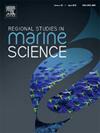Large polluted river plumes threats sustainable mariculture in the Baia da Ilha Grande
IF 2.1
4区 环境科学与生态学
Q3 ECOLOGY
引用次数: 0
Abstract
Ilha Grande Bay (BIG) has sustained significant scallop production, but its production has declined in the last ten years, possibly due to pollution and global changes. Rivers in BIG that cross densely populated areas are a primary source of sewage pollution. The study aimed to analyze the abundance of coliform bacteria during the dry and rainy seasons in ten rivers in BIG and in five sites near scallop farms. Subsequently, a model was developed to estimate the dispersion of bacteria in this Bay. The model combines bacterial abundance values and a Lagrangian hydrodynamic approach. The results showed high levels of fecal contamination at the monitored points, being above those indicated for shellfish farming and recreation. The spatial variation of the levels of fecal indicator bacteria in the river water is related to the human population living within a radius of 3.1 km² from the mouth of each river basin. The dispersion model obtained from the river plumes showed that the ten river plumes correspond to an area of 11.700 km². Mambucaba, Jacuecanga and Jacareí account for 7.320 km² (62 % of the river's plumes). These three rivers are also among the most polluted (up to 10.000 CFU/mL of coliforms). The synergistic effects of reduced ocean circulation in winter and high precipitation in summer exacerbate coliform levels within the BIG, which is detrimental to bivalve mariculture. The proposed model serves as a useful tool for the establishment of new mariculture farms.
求助全文
约1分钟内获得全文
求助全文
来源期刊

Regional Studies in Marine Science
Agricultural and Biological Sciences-Ecology, Evolution, Behavior and Systematics
CiteScore
3.90
自引率
4.80%
发文量
336
审稿时长
69 days
期刊介绍:
REGIONAL STUDIES IN MARINE SCIENCE will publish scientifically sound papers on regional aspects of maritime and marine resources in estuaries, coastal zones, continental shelf, the seas and oceans.
 求助内容:
求助内容: 应助结果提醒方式:
应助结果提醒方式:


